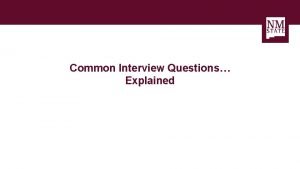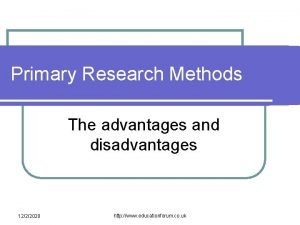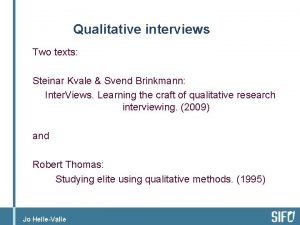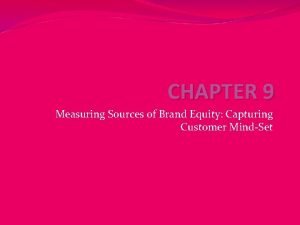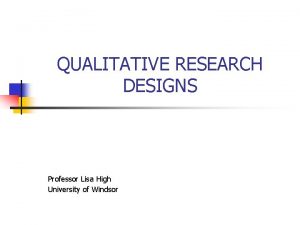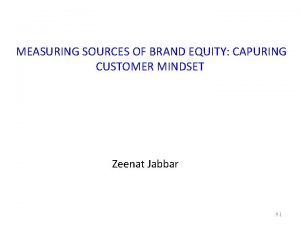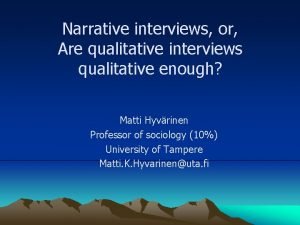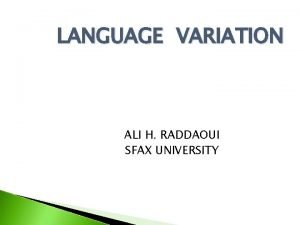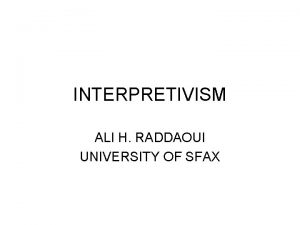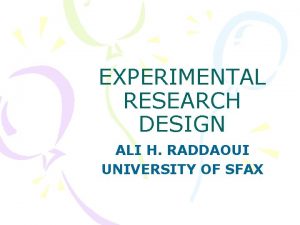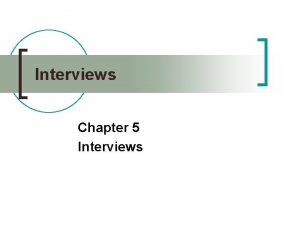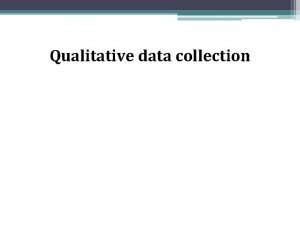QUALITATIVE TECHNIQUES INTERVIEWS ALI H RADDAOUI INTERVIEWS AND









- Slides: 9

QUALITATIVE TECHNIQUES INTERVIEWS ALI H. RADDAOUI

INTERVIEWS AND OBSERVATIONS n n Interviews, rather than paper and pencil surveys allow evaluators capture the perspectives of participants Assumptions n n Participants’ perspectives are meaningful, knowable, and able to be made explicit. Interpersonal contact is important; opportunities for followup of interesting comments are desired.

TWO TYPES OF INTERVIEW n Structured interviews n n Carefully worded questionnaire is administered Answers to carefully phrased questions Interviewers deviate only minimally from the question wording to ensure uniformity of interview administration to ensure uniformity of interview adiminstration In-depth interviews: interviewer does not follow a rigid form. n n n Capture respondents’ perceptions in their own words Present Meaningfulness of the experience from the respondent’s perspective. Interviewers seek to encourage free and open responses Tradeoff between comprehensive coverage of topics and in-depth exploration of a more limited set of questions. Conducted with individuals or with a small group of individuals. 4

RECORDING INTERVIEW DATA n n Data to be recorded on tape (with the permission of the participants) and/or summarized in notes. Written notes taken of interview session

THREE WAYS TO RECORD INTERVIEW DATA -- 1 1. interviewer (or in some cases the transcriber) listens to the tapes and writes a verbatim account of everything that was said. Transcription of the raw data includes • word-for-word quotations of the participant’s responses • interviewer’s descriptions of participant’s characteristics, enthusiasm, body language, and overall mood during the interview. • Notes from the interview can be used to identify speakers or to recall comments that are garbled or unclear on the tape. • When to use this approach: n necessary financial and human resources are available, n transcriptions can be produced in a reasonable amount of time n focus of the interview is to make detailed comparisons, n respondents’ own words and phrasing are needed.

ADVANTAGES AND DISADVANTAGES • • • Advantages: n completeness and the opportunity it affords for the interviewer to remain attentive and focused during the interview. Disadvantages n The amount of time and resources needed to produce complete transcriptions and the inhibitory impact tape recording has on some respondents. Requirements: participants must be informed that their answers are being recorded, that they are assured confidentiality, and that their permission has been obtained.

THREE WAYS TO RECORD INTERVIEW DATA -- 2 n n Less emphasis on the word-by-word record and more on the notes taken by the interviewer or assigned notetaker. Name of method: "note expansion. " n n When is this approach recommended? n n n As soon as possible after the interview, the interviewer listens to the tape to clarify certain issues and to confirm that all the main points have been included in the notes. resources are scarce, results must be produced in a short period of time, purpose of the interview is to get rapid feedback from members of the target population. Advantage: saves time and retains all the essential points of the discussion. Disadvantages: interviewer may be more selective or biased in what he or she writes.

THREE WAYS TO RECORD INTERVIEW DATA -- 3 n n no tape recording used detailed notes are taken during interview Drawing on memory to expand clarify the notes immediately after the interview When is this approach recommended? n n time is short, results are needed quickly evaluation questions are simple Disadvantages: n n Mastery of effective note taking is difficult in case of complex questions Interviewer must frequently talk and write at the same time, a skill that is hard for some to achieve

SOURCE n Directorate for Education and Human Resources. Division of Research, evaluation and Communication. National Science Foundation. User-Friendly Handbook for Mixed Method Evaluations. PART II. Overview of Qualitative Methods and Analytic Techniques. Chapter 3. Common Qualitative Methods. Retrieved from the World Wide Web, February 12, 2005. http: //www. ehr. nsf. gov/EHR/REC/pubs/NSF 97 -153/CHAP_3. HTM
 Type of data collected in quantitative research
Type of data collected in quantitative research Barbara cons
Barbara cons Leadership strengths and weaknesses list
Leadership strengths and weaknesses list Disadvantages of primary research
Disadvantages of primary research Type scale
Type scale Kvale interviews
Kvale interviews Research sample definition
Research sample definition Qualitative research techniques to measure brand equity
Qualitative research techniques to measure brand equity Sampling techniques in qualitative research
Sampling techniques in qualitative research Measuring sources of brand equity
Measuring sources of brand equity


